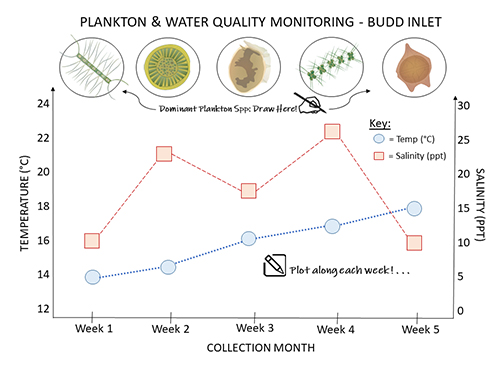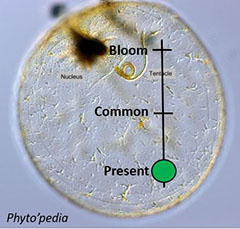Collect Data
Join PSI at the Port Plaza dock (lower Budd Inlet) every Thursday this summer from 10:00-12:00! No reservations required.
Discover "What's Blooming in Budd?" and view weekly plankton photos and water quality data by clicking here: What's Blooming This Week?
Every week, PSI biologists dip their net into Budd Inlet to track plankton communities and screen for harmful algal blooms, or HABs. HABs are blooms of phytoplankton that cause harm to people, animals, or local water quality. This data will be submitted to NOAA’s SoundToxins program, a phytoplankton monitoring network designed to provide early warning of HABs in an effort to protect human health and economic losses to fisheries.
Analyze Data
What can we learn from our data? Monitoring water quality helps us recognize trends, patterns and changes over time. For example, the data that we collect ultimately helps researchers forecast HAB events and better understand how changing climate conditions impact plankton communities.
Plot-Along-At-Home
To track plankton communities and water quality over the summer print a Plot-Along-At-Home graph template or draw your own. You can even create your own template based on your individual research questions. How do temperature and salinity differ between the surface and depth? Is there a relationship between temperature and HAB concentrations? Plot the data and find out! Data can be found at the end of the "What's Blooming This Week?" document. Share your graphs with us! We'd love to see your results!

Take Action
Build your own plankton net using a soda bottle, nylon stockings and duct tape.
Starting September 1, 2022, you can check out one of PSI's Discover Plankton Lendable Kits at the Olympia, Tumwater and Lacey Timberland Libraries! Kits include a plankton net, microscope, ID guides and more! Thank you Keta Legacy! You are always welcome to drop by our office to view your plankton samples under our amazing Olympus Inverted microscope. Contact Aimee Christy or Mary Elizabeth to schedule a visit!
Did you know that Budd Inlet experiences low oxygen concentrations during late summer? Excess nutrients fuel phytoplankton blooms that ultimately sink to the bottom of the inlet. Bacterial decomposition of this organic matter robs the water of valuable oxygen resulting in stressful conditions for marine life. Learn about nutrient pollution and what actions you can take to reduce your personal input into Puget Sound. Picking up pet waste, composting, and washing your car at a car wash (or on your lawn) are a few ways to improve water quality.
More Information
For more information, contact PSI's Aimee Christy or Mary Elizabeth (360-754-2741). Thank you to our generous funders! Without your support, this important work would not be possible!
 
Learn More: Monitoring programs and plankton identification |
|
|
|
|
|
|
|
|
What's Blooming This Week?

Location: Port Plaza, Budd Inlet
Sample Date: September 5, 2024
Vertical Net Tow Depth: 4.5 -meters
Dominant Species: Skeletonema
Common Species: Polykrikos, Scrippsiella,Akashiwo
# of Species Observed: 33
Harmful Algal Bloom (HAB) species: Dinophysis, Akashiwo, Noctiluca
# of HABs (cells/L): Dinophysis (12 cells/L), Akashiwo (417 cells/L, Noctiluca (95 cells/L). |
|
Noctiluca Gauge - Forecasting a bioluminescent night show!

2023 Final Report (PDF)
2022 Final Report (PDF)
2021 Final Report (PDF)
2020 Final Report (PDF)
2019 Final Report (PDF))
2018 Final Report (PDF)
2017 Final Report (PDF) |
|
|
|